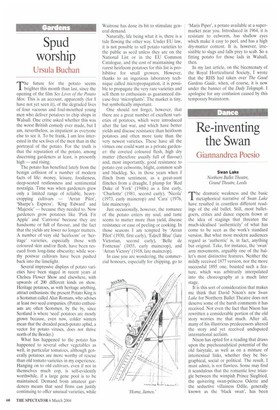Spud worship
Ursula Buchan
The future for the potato seems brighter this month than last, since the opening of the film Sex Lives of the Potato Men. This is an account, apparently (for I have not yet seen it), of the degraded lives of four vacuous and foul-mouthed young men who deliver potatoes to chip shops in Walsall. One critic asked whether this was the worst British comedy ever made, but I am, nevertheless, as impatient as everyone else to see it. To be frank, I am less interested in the sex lives of the men than in the portrayal of the potato. For the truth is that the reputation of the potato, among discerning gardeners at least, is presently high — and rising.
The potato has benefited lately from the benign collision of a number of modern facts of life: money, leisure, foodieness, deep-seated restlessness and sentimental nostalgia. Time was when gardeners grew only a limited range of reliable, heavycropping cultivars — 'Arran Pilot', 'Sharpe's Express', 'King Edward' and 'Majestic' — because they needed to. Now gardeners grow potatoes like 'Pink Fir Apple' and `Catriona' because they are handsome or full of flavour, and the fact that the yields are lower no longer matters. A number of very old 'heirloom' or 'heritage' varieties, especially those with coloured skin and/or flesh, have been rescued from long-time obscurity; while worthy postwar cultivars have been pushed back into the limelight.
Several impressive displays of potato varieties have been staged in recent years at Chelsea Flower Show and elsewhere, with upwards of 200 different kinds on show. Heritage potatoes, as with heritage anything, attract enthusiasts; the present Potato King is a Scotsman called Alan Romans, who advises at least two seed companies. (Potato enthusiasts are often Scotsmen. by the by, since Scotland is where 'seed' potatoes are mostly grown because, even now, colder winters mean that the dreaded peach-potato aphid, a vector for potato viruses, does not thrive north of the Border.) What has happened to the potato has happened to several other vegetables as well, in particular tomatoes, although generally potatoes are more worthy of rescue than old tomato varieties in my experience. Hanging on to old cultivars, even if not in themselves much cop, is self-evidently worthwhile, if a large gene pool is to be maintained. Demand from amateur gardeners means that seed firms can justify continuing to offer unusual varieties, while Waitrose has done its bit to stimulate general demand.
Naturally, life being what it is, there is a tide flowing the other way. Under EU law, it is not possible to sell potato varieties to the public as seed unless they are on the National List or in the EU Common Catalogue, and the cost of maintaining the rarest heirloom potatoes for this list is prohibitive for small growers. However, thanks to an ingenious laboratory technique called micropropagation, it is possible to propagate the very rare varieties and sell them to enthusiasts as guaranteed disease-free `microplants'. The market is tiny, but symbolically important.
One should not forget, however, that there are a great number of excellent varieties of potatoes, which were introduced after the last war, and which have better yields and disease resistance than heirloom potatoes and often more taste than the very newest varieties. These have all the virtues one could want as a private gardener: the coveted coloured flesh, high dry matter (therefore usually full of flavour) and, most importantly, good resistance to potato cyst eelworms, blight, common scab and blackleg. So, in those years when I flinch from sentiment, as a great-aunt flinches from a draught, I plump for 'Red Duke of York' (1940s) as a first early, 'Charlotte' (1981, second early), 'Nicola' (1973, early maincrop) and 'Cara' (1976, late maincrop).
Just occasionally, however, the romance of the potato enters my soul, and taste seems to matter more than yield, disease resistance or ease of peeling or cooking. In those seasons I am tempted by 'Arran Pilot' (1930, first early), `Edzell Blue' (late Victorian, second early), 'Belle de Fontenay' (1855, early maincrop), and 'Arran Victory' (1918, late maincrop).
In case you are wondering, the commercial honours, especially for chipping, go to 'Mans Piper', a potato available at a supermarket near you. Introduced in 1964, it is resistant to eelworm, has shallow eyes which make it easy to peel, and has a high dry-matter content. It is, however, irresistible to slugs and falls prey to scab. So a fitting potato for those lads in Walsall, then.
In my last article, on the bicentenary of the Royal Horticultural Society, I wrote that the RHS had taken over The Good Gardens Guide, when, of course, it is now under the banner of the Daily Telegraph. I apologise for any confusion caused by this temporary brainstorm.


















































































 Previous page
Previous page